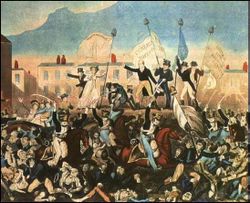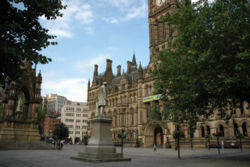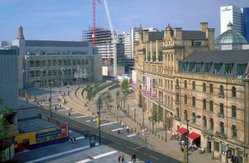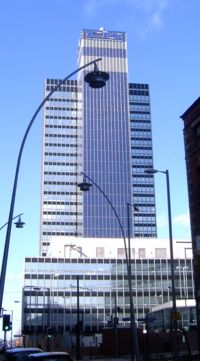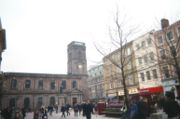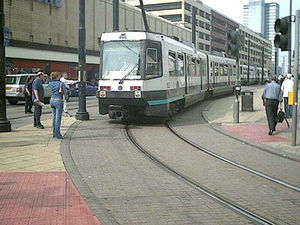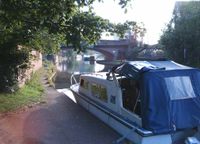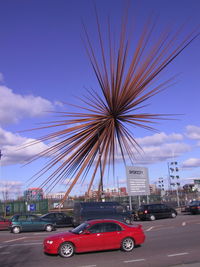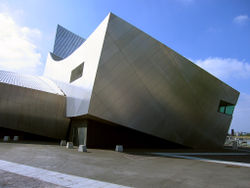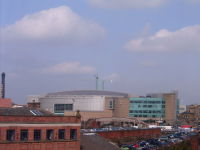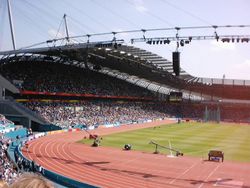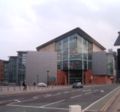Manchester
2007 Schools Wikipedia Selection. Related subjects: Geography of Great Britain
Manchester is a major city within Greater Manchester in North West England, historically notable for being the world's first industrialised city, and its subsequent central role in the Industrial Revolution. The city, heralded as the " Capital of the North", is a centre of the arts, the media, higher education and commerce, and is considered by many of its citizens to be England's second city.
The City of Manchester is a metropolitan borough with City status. The metropolitan borough has a population of 441,200, while the Greater Manchester Urban Area is home to 2,240,230 people, making it England's third largest conurbation after those of Greater London and the West Midlands.
Manchester is well known for its sporting connections being associated with two major Premiership League football teams, Manchester City and Manchester United and for having hosted the XVII Commonwealth Games in 2002.
Manchester city centre is on a "tentative list" of UNESCO World Heritage Sites—mainly based around its network of canals and mills, which facilitated its development during the Industrial Revolution of the 19th century.
Manchester has been occasionally called Cottonopolis, as during the Industrial Revolution, it was a leading international centre of cotton spinning. More recently the city has been referred to as ' Madchester' due to the city's prominent music scene of the same name.
The Greater Manchester county consists of the City of Manchester and the other metropolitan boroughs which surround it: Trafford, Tameside, Salford, Wigan, Bolton, Bury, Oldham, Rochdale and Stockport. The Manchester postal area contains parts of all ten boroughs except Stockport - Salford and Sale form separate post towns within the area.
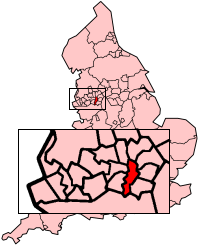 Shown within England |
|
| Geography | |
| Status | Metropolitan borough, City (1853) |
|---|---|
| Ceremonial county | Greater Manchester |
| Historic county | Lancashire (some parts from Cheshire) |
| Region | North West England |
| Constituent country | England |
| Sovereign state | United Kingdom |
| Area - Total |
Ranked 228th 115.65 km² |
| Admin HQ | Manchester ( Manchester Town Hall) |
| ISO 3166-2 | GB-MAN |
| ONS code | 00BN |
| OS grid reference | SJ843983 |
| Coordinates | 53°29N 2°15W |
| NUTS 3 | UKD31 |
| Demographics | |
| Population: Total (2005 est.) Density |
Ranked 6th 441,200 3,815 / km² |
| Ethnicity ( 2001 census) |
81.0% White 9.1% S. Asian 4.5% Afro-Carib. 1.3% Chinese |
| Politics | |
 Manchester City Council http://www.Manchester.gov.uk/ |
|
| Leadership | Leader & Cabinet |
| Control | Labour |
Etymology
The name "Manchester" came from the Roman name Mamucium, thought to be a Latinisation of an original Celtic name (possibly meaning "breast-like hill" from mamm- = " breast"), plus Anglo-Saxon ceaster = " town", which is derived from Latin castra = "camp".
History
Early history
The Manchester area was settled in or before Roman times. The original fort was constructed by General Gnaeus Julius Agricola as a staging post between Chester (Deva) and York (Eboracum). This Roman settlement was named Mamucium ( Celtic for " breast-shaped hill") after the hill that it was sited on to be better defensible. The original location of the fort is now in the City of Salford.
The fort was abandoned in the Dark Ages, and at some point in time the focus of settlement shifted from this spot to the confluence of the rivers Irwell and Irk.
In medieval times, this area included a fortified manor house. Thomas De La Warre, a manorial lord who also happened to be a priest, gave the site to the church for use as a College of Priests around 1422, and commenced the construction of the Collegiate Church. The former is now Chetham's School of Music, and the latter Manchester Cathedral.
Manchester became a market town in 1301 when it received its Charter. In this period Manchester grew heavily due to a influx of Flemish settlers who founded Manchester's new cotton industry and sparked the growth of the city to become Lancashire's major industrial centre. The ancient parish of Manchester covered a wider area than today's metropolitan borough (although not including its full extent), with the various townships and chapelries becoming recognised as separate civil parishes in 1866.
During the 19th Century Manchester grew to become to the centre of Lancashire's cotton industry and was dubbed " Cottonopolis". During this period Manchester had its world famous canal system built as well as the famous Liverpool and Manchester Railway. Manchester quickly grew into the most important industrial centre in the world, and, significantly, the first industrial society. The pace of change was fast and frightening. At that time, it seemed a place in which anything could happen — new industrial processes, new ways of thinking (the so called 'Manchester School', promoting free trade and laissez-faire), new classes or groups in society, new religious sects, and new forms of labour organisation. It attracted educated visitors from all parts of Britain and Europe. "What Manchester does today," it was said, "the rest of the world does tomorrow." Also during this period Manchester saw a rise in its population as Lancastarians, the Irish, Jews and many other people immigrated to the city.
As well as being a centre of capitalism the city saw its fair share of rebellion by the working and non-titled classes, with the most famous being the events on St Peter’s Field on 16 August 1819 which have become known as ' Peterloo'. The first Trades Union Congress was held in Manchester (at the Mechanics' Institute, David Street), from 2 to 6 June 1868. Manchester was the subject of Freidrich Engels' The Condition of the Working Class in England in 1844, Engels himself spending much of his life in and around Manchester. Manchester was also an important cradle of the Labour Party and the Suffragette Movement.
Manchester's golden age was perhaps the last quarter of the nineteenth century. Many of the great public buildings (including the Town Hall) date from then. The city's cosmopolitan atmosphere contributed to a vibrant culture, which included the Hallé Orchestra. In 1889, when county councils were created in England, the municipal borough became a county borough with even greater autonomy. During this period, the Manchester Ship Canal was created by the canalisation of the Rivers Irwell and Mersey for 36 miles from Salford to the Mersey estuary at the port of Liverpool. This enabled ocean going ships to sail right into the Port of Manchester Docks (technically in Salford). The docks functioned up until the 1970s, with their closure leading to a large increase in unemployment in the area.
Trafford Park in Stretford was the world's first industrial estate and still exists today, though with a significant tourist and recreational presence. Manchester suffered greatly from the inter-war depression and the underlying structural changes that began to supplant the old industries, including textile manufacture.
During the World War II, Manchester was involved in heavy industrial construction — it was home to Avro (now BAE Systems) which built countless aircraft for the RAF, the most famous being the Avro Lancaster bomber. The city was attacked a number of times by the Luftwaffe, particularly in the "Christmas Blitz" of 1941, which destroyed a large part of the historic city centre and seriously damaged the Cathedral.
In 1974, Manchester was split from the county of Lancashire, and the Metropolitan Borough of Manchester was created.
Recent history
At 11.20 am on Saturday 15 June 1996, the IRA detonated a large bomb in the city centre, the largest to be detonated on British soil. Whilst this bomb caused over 200 injuries, it caused no deaths, and the principal damage was to the physical infrastructure of nearby buildings. The consequent reconstruction spurred a massive regeneration of the city centre, with complexes such as The Printworks and the Triangle creating new city focal points for both shopping and entertainment. The regeneration took over a decade to complete. The latest and final part of the renovated Manchester Arndale opened in September 2006, allowing the centre to hold the title of Europe's largest city centre shopping mall. In 2002, the city successfully hosted the XVII Commonwealth Games, earning praise from many sources. Manchester has twice failed in its bid to host the Olympic Games, losing to Atlanta in 1996 and Sydney in 2000.
Rapidly developing institutions attract crime and disorder; see main article crime and policing in Manchester.
Since the regeneration after the 1996 IRA bomb, and aided by the XVII Commonwealth Games, Manchester's city centre has changed significantly. Large sections of the city dating from the 1960s have been either demolished and re-developed or modernised with the use of glass and steel; a good example of this transformation is the Manchester Arndale. Many old mills have been converted into apartments, helping to give the city a much more modern, upmarket look and feel. Some areas, like Hulme, have undergone extensive regeneration programmes and many million-pound lofthouse apartments have since been developed to cater for its growing business community. The 168 metre tall, 47-storey Beetham Tower, completed in 2006, provides the highest residential accommodation in the United Kingdom - the lower 23 floors form the Hilton Hotel, while the upper 24 floors are apartments. The Beetham Tower was originally planned to stand 171 metres in height, but this had to be changed due to local wind conditions.
Physical geography
Manchester lies in a bowl-shaped land area bordered to the north and east by the Pennine hills and to the south by the Cheshire Plain. The city centre is on the east bank of the River Irwell, near the confluence of the River Medlock and the River Irk and is relatively low-lying, being between 35 and 42 metres (115 to 138 ft) above sea level. The River Mersey flows through the south of Manchester. Much of the inner city, especially in the south, is flat, offering extensive views of the moors from the top floors of many high buildings. Manchester's geographic features were highly influential in its early development as the world's first industrial city. These features are its climate, its proximity to a seaport at Liverpool, the availability of water power from its rivers, and its nearby coal reserves.
Climate
Manchester has a relatively damp climate and a reputation as a rainy city. The average annual rainfall is 809 mm, (902 mm from some sources)meaning that its reputation is relatively undeserved. For example, this total is less than that of Plymouth, Cardiff or Glasgow. In international terms, Manchester receives substantially less rain than New York City, which receives 1200 mm of rain in an average year, and its average annual rainfall total is comparable with that of Rome. The precipitation is regularly light and prolonged, however, so a small volume of rain may take an hour to fall in Manchester, compared to several minutes of heavy rain experienced in Rome. Manchester also has a relatively high humidity level, which lent itself to the optimised and breakage-free textile manufacturing which took place in the city. Snowfall is rare in the city itself, being low-lying, towards the west coast and an urban landscape.
| Month | Jan | Feb | Mar | Apr | May | Jun | Jul | Aug | Sep | Oct | Nov | Dec | Year |
|---|---|---|---|---|---|---|---|---|---|---|---|---|---|
| Average max. temperature ° C (° F) |
6 (44) |
6 (44) |
8 (48) |
11 (52) |
15 (59) |
17 (64) |
19 (67) |
19 (67) |
16 (62) |
13 (55) |
8 (48) |
7 (45) |
12 (55) |
| Average min. temperature °C (°F) |
1 (35) |
1 (35) |
2 (37) |
4 (40) |
7 (45) |
10 (50) |
12 (54) |
12 (54) |
10 (50) |
7 (45) |
4 (40) |
2 (37) |
6 (44) |
| Rainfall mm ( inches) |
71 (2.8) |
58 (2.3) |
58 (2.3) |
51 (2.0) |
64 (2.5) |
71 (2.8) |
86 (3.4) |
94 (3.7) |
81 (3.2) |
94 (3.7) |
84 (3.3) |
86 (3.4) |
902 (35.5) |
| Source: Weatherbase | |||||||||||||
Politics and administration
See Politics in Manchester
Economics
Manchester has many office buildings, and its Central Business District is currently in the centre of the city, adjacent to Piccadilly, focused on Mosley Street, Deansgate, King Street and Piccadilly. However, new office space is appearing rapidly throughout the city, as its reputation as a high quality European Business Centre increases. Spinningfields is a large new development west of Deansgate; it will be a large, modern business centre, and home to several headquarters, squares, and cafes. The first building on the site was the Royal Bank of Scotland's new headquarters on Deansgate. The project is being spear-headed by Sir Norman Foster. Other buildings include a 110 metre tall office building, a new justice centre and new Crown Court, to be built over the next few years.
Just outside the city centre, a new business district is appearing in Salford Quays, regenerated ex-shipping docks similar to London's Docklands, and is home to headquarters and call centres for many major companies. The announcement in June 2006 that the BBC hopes to relocate several departments to the Quays from London is sure to further expand the area as Greater Manchester's second major Business District.
Shopping
Manchester is the main retail centre of the North. There are two large shopping malls; the Manchester Arndale in the middle of the city and the out-of-town Trafford Centre. The city centre has a number of smaller shopping centres, including The Triangle, which caters for a more youthful and upmarket clientele and the Royal Exchange Centre. Manchester also has one of the largest ASDA-WalMart supercentres in the UK, close to the City of Manchester Stadium in Eastlands.
In the central shopping area of the city centre, road access is all but impossible, making journeys around the city on foot quicker, safer and more convenient. The pedestrianised Market Street forms the core of the city centre's retail area. It is dominated on the north side by the Manchester Arndale and a branch of Debenhams.
The Shambles contains a branch of Harvey Nichols, a Marks and Spencer store, and a branch of Selfridges, as well as a variety of upmarket designer boutiques.
Deansgate also has many shops, including the department store House of Fraser (formerly Kendals), along with pubs and bars. King Street is an affluent shopping area where many exclusive fashion brands have stores. King Street also has many notable buildings preserved in a conservation area. Other hubs in the centre include St Ann's Square, and Exchange Square.
Former stores, since gone, include Lewis's, Henry's, and Affleck and Brown. The building that housed Affleck and Brown is now known as Affleck's Palace. It consists of low-cost stalls for independent traders and creatives. Affleck's is on Oldham Street, in the Northern Quarter, along with a range of independent music, clothing, and other shops.
Food and drink
Manchester has a range of restaurants, bars, and clubs, spanning the famous "curry mile" in Rusholme to traditional ‘grub’, Chinatown, modern bars and bistros at Deansgate Locks in the city centre. There are now many top class restaurants.
There is a Hard Rock Cafe, chain restaurants such as Wagamama and bars that include Waxy O’Connors and The Living Room. The coffee chain Starbucks has 12 outlets in a 2 mile radius. Other, independent restaurants, bars and clubs can be found in the Northern Quarter area of the city centre.
Manchester is also famous for its beer, despite the closure of the Boddingtons brewery in 2005. Keg 'Boddies' is brewed by Interbrew in Luton but cask Boddington's continues to be brewed in the city by Hydes brewery in Moss Side. Hydes is a long established independent brewery. Another Manchester brewer is Joseph Holt, whose Derby Brewery in Cheetham is just round the corner from the defunct Boddingtons Strangeways brewery. The Royal Brewery in Moss Side — not far from Hyde's — brews McEwans lager. J W Lees brewery is in Middleton Junction, a few miles north of the city. There are also a notable number of microbreweries producing smaller quantities of high quality beer, cider and perry.
Breweries in Manchester and Salford which closed within the last twenty years include Wilson's, whose Newton Heath brewery closed in the late 1980s, and Whitbread/Chester's in Salford.
Demographics
The United Kingdom Census 2001 showed a total population for Manchester of 392,819, a 9.2% decline on the figure from the previous census, ten years before. Of the 2001 total, 191,570 Mancuians were male and 201,249 female. 82,788 were aged under 16, 284,994 16 to 74, and 25,037 aged 75 and over.
Ethnicity
81% of people identified themselves as "White", 5.9% as "Pakistani", 2.3% as "Black Caribbean" and 1.4% as "Black African".
Religion
Stated religions in order of prevalence:
- Christian 62.4%
- No religion 16.0%
- Religion not stated 9.7%
- Muslim 9.1%
- Jewish 0.8%
- Hindu 0.7%
- Buddhist 0.5%
- Sikh 0.4%
- Other 0.3%
Economic activity
Manchester reported the second-lowest proportion of the population in employment of any area in the United Kingdom. Although unemployment in Manchester is higher than average, the primary reason for Manchester's low level of employed people is the very high proportion of the population who are students.
Education
Universities
Manchester is home to two major universities: the University of Manchester and Manchester Metropolitan University are to the south of the city. The University of Manchester is the largest full-time non-collegiate university in Britain, and was created in autumn 2004 by the merger of Victoria University of Manchester and UMIST. Manchester Metropolitan University was formed out of the old polytechnic college in the city.
The University of Manchester, Manchester Metropolitan University and the Royal Northern College of Music are all grouped together on the southern side of the city centre, and effectively form one large campus around Oxford Road.
Schools
Manchester's most notable secondary school is the Manchester Grammar School, an independent (what would be termed "private" in other English-speaking countries) boys' school, for pupils aged 11–18, in Fallowfield, South Manchester. In the post-war period, it was a direct-grant grammar school, which charged no fees, but it became an independent school in 1976 after the Labour government removed funding from direct-grant grammar schools. Originally situated in the centre of the city, in a prominent position close to the Cathedral, it has since relocated to Old Hall Lane in Fallowfield, to accommodate the growing student body. Its previous premises are now used by Chetham's School of Music.
Religion
The Anglican Diocese of Manchester was established in 1847. Manchester has also has an Anglican cathedral, St Mary, St George's and St Denys' Cathedral. It was built over a period of 600 years and is built in the Gothic Style.
Manchester lies within the Roman Catholic Diocese of Salford. The oldest surviving Catholic church is St Mary's The Hidden Gem, on Mulberry Street in the city centre. Manchester is in the Central North Division of the Salvation Army.
Manchester has a large Muslim population, and the UK's largest Jewish community outside London.
- See also: The Salvation Army in Manchester
Places of interest
Architecture
Manchester has a wide variety of buildings mainly from Victorian architecture through to modern. Much of the architecture in the city harks back to its former days as a global centre for the cotton trade. Many warehouses have now been converted for other uses but the external appearance remains mostly unchanged so the city keeps much of its original character. An interesting facet of the architecture of Manchester and several other cities which underwent a construction boom during the industrial revolution is that inspiration was taken from Venice. Examples of this architecture can be easily found to the south and east of Albert Square and near the 92nd lock of the Bridgewater Canal, near Beetham Tower.
Manchester also has a number of skyscrapers. Most were built during the sixties and seventies. However, in the last few years there has been a renewed interest in building skyscrapers in Manchester. Numerous residential and office blocks are being built or have recently been built in the city centre. Beetham Tower was completed in the Autumn of 2006 and houses a Hilton hotel along with a restaurant and residential properties. It is currently the tallest building in the UK outside London. However, this status may be short lived, an even taller building is proposed behind Manchester Piccadilly station.
Other structures of interest in Manchester include:
| Key | |
| |
National Trust |
| |
English Heritage |
| |
Forestry Commission |
| Country Park | |
| Accessible open space | |
| Museums (free/not free) | |
| Heritage railway | |
| Historic House | |
- Old Trafford Cricket Ground, Lancashire County Cricket Club
Public monuments
Within Manchester there are monuments to numerous people and events that have helped to shape the city and influence the wider community. Two large squares, Albert Square, in front of Manchester Town Hall, and Piccadilly Gardens hold many of Manchester’s public monuments.
Notable monuments elsewhere in the city include the Alan Turing Memorial situated in Sackville Park close to Canal street remembers the father of modern computing. A monument to Abraham Lincoln in Lincoln Square marks the cotton famine of 1861–1865. Finally, the success of the 2002 Commonwealth Games is commemorated by B of the Bang, Britain’s tallest sculpture, located near the City of Manchester Stadium.
Streets and plazas
Manchester has a number of busy squares, plazas and shopping streets. Many of Manchester city centre's streets are now pedestrianised with numerous other streets having Metrolink or Bus priority, this makes driving around Manchester City Centre complicated.
One of the oldest thoroughfares is Market Street. This was originally called Market Stede Lane. Much of the medieval street pattern, around the original Market Place was cleared as part of 1970s developments. Ancient streets such as Smithy Door were lost forever. One ancient street to survive is Long Millgate, which led north from the old Market Place. This winding lane, crossing Fennel Street and leading on to Todd Street (formerly Toad Lane - thought to be a corruption of T'owd Lane - The Old Lane) is now an attractive and peaceful thoroughfare, bounded by gardens.
Whitworth Street is a broad 19th century route, stretching from Deansgate to London Road, running parallel to the Rochdale Canal for much of its route, and intersecting with Princess Street, Chepstow Street and Albion Street along the way. The street is bounded by impressive brick buildings, formerly warehouses, but now mostly residential developments.
Mosley Street runs roughly parallel to Portland Street, Whitworth Street and Deansgate, leading from Piccadilly Gardens to St Peter's Square. The street is closed to general traffic, with the Metrolink running trams along its route.
Another Victorian addition to the city's street pattern was Corporation Street, which cut through slums to the north of Market Street and provided a direct link from Cross Street (and the newly constructed Albert Square) to the routes north of the city.
To the south of the city centre, Wilmslow Road is the hub of much student life and is home to Manchester’s curry mile.
Other notable places in Manchester include:
- Great Northern Square
- Spring Gardens
- Cathedral Gardens
- New Cathedral Street
- The Gay Village
- Chinatown — the largest Chinatown in the UK and the second largest in Europe
Transport and infrastructure
Manchester is very well served in terms of transport and infrastructure. The roads of Manchester are some of the most extensive in the UK and statistically Greater Manchester has a higher percentage of the motorway network than any other county in the country. According to The Guinness Book of World Records, it has the most traffic lanes side by side (17), spread across several parallel carriageways. ( M61 at Linnyshaw Moss, Greater Manchester, close to the M60 interchange).
Mancunians are often adventurous, with high sales of air tickets to international and national destinations with most travelling from Manchester Airport. The Liverpool and Manchester Railway was the first passenger railway in the world. Today, Greater Manchester still has an extensive citywide railway network, and two mainline stations.
Other forms of transport in Manchester are the famous Black Cabs which are reasonably priced compared to other cities and there are plenty of taxi stands. You can also call for a minicab direct to your location, with many firms providing this service. The biggest in Manchester is Street Cars, which is also the name of the taxicab firm in Coronation Street.
Air
Manchester Airport, formerly Manchester Ringway Airport, is the third busiest airport in the UK in terms of passengers per year. The busier airports are London's Heathrow and Gatwick. It is served by a dedicated railway station. In 2005 the airport handled 22.1 million passengers and provided direct flights to over 180 destinations worldwide by over 90 airlines. Long haul scheduled destinations served directly from Manchester include New York ( JFK and Newark), Chicago, Boston, Philadelphia, Atlanta, Orlando, Miami, Houston, Las Vegas, Toronto, Port of Spain, Antigua, Barbados, Damascus, Dubai, Abu Dhabi (starting Spring 2006), Doha, Tehran, Karachi, Islamabad, Lahore, and Singapore. There are also firm plans for direct services to Beijing and Bangkok. Many European and domestic destinations are served. Manchester to London is one of the high density airline routes within the UK and is one of the busiest domestic sectors in Europe, but is now experiencing serious competition from the improved railway links.
The airport has been voted the best airport in the UK by Which Consumer Magazine, Travel Weekly Globe, Business Magazines International for the second year running and in the Airport World’s Service Excellence Awards (European runner up, second only to Copenhagen).
Barton Aerodrome, one of the world's oldest airports, opened in 1930 and still in operation. It is a very busy light aviation airfield with small grass runways which deal with small aircraft. It also has the world's oldest operating aircraft control tower, completed in 1933.
Road
Manchester, like London, has an outer ring road: the M60. Unlike London's M25 the M60 actually runs within the Greater Manchester conurbation providing good links, rather than around the conurbation as the M25 does. It has 27 junctions, numbered consecutively clockwise, starting with Junction 1 at Stockport in the south-east of the conurbation. The second busiest section of road in the UK after a section of the M25 (Junctions 13 & 14 Heathrow) is the M60 north of Manchester between junctions 16 and 17.
The city also has an inner ring road. Part of this is the A57/ A57(M) (also known as Mancunian Way), which runs south of the city centre, linking the western M602 (which spurs from the M60) to the eastern M60 and M67.
The other main motorways serving Manchester are the M56 (to the airport, Chester and the M6 southbound to Birmingham), the M61 (to Bolton, Preston and the M6 northbound to Lancaster), the M62 (to Liverpool, Leeds and Kingston upon Hull), the M66 (to Bury) and the M67, which was originally built as a route to Sheffield but was cancelled long before completion. All of these motorways connect onto the M60.
Rail
Manchester holds a pivotal position in railway history as a birthplace of passenger rail travel on the Liverpool and Manchester Railway, which opened in 1830 after the famous Rainhill Trials chose Stephenson's Rocket to pull the trains. In just 50 years the city centre was encircled by stations and termini, including Manchester London Road Station, (now Manchester Piccadilly), Manchester Victoria, Manchester Central Railway Station, Manchester Mayfield Station and Manchester Exchange Station. Following the Beeching Report in the 1960s, cutbacks followed, with Manchester Central, Manchester Mayfield and Manchester Exchange closing to passengers. All rail services were then directed to Manchester Victoria and Manchester Piccadilly. High speed trains to London are run from Manchester Piccadilly by Virgin Trains, journeys typically taking around 2 hr 15 min. There are also several smaller stations remaining around the City Centre, including Manchester Oxford Road station, Deansgate railway station and Salford Central railway station.
Although there is no Underground Railway system similar to Glasgow's or London's, the city has had several failed attempts to create one including the infamous " Picc-Vic tunnel", a heavy rail tunnel linking the main stations. Excavation work under the Manchester Arndale for this project began in the 1970s, but was soon abandoned due to costs and rumours of 'subterranean obstacles'. This may well have referred to the ' Guardian' underground nuclear bunker network, originally constructed by as a means of protecting communications in the city in the event of an atom bomb being deployed and now used by BT. Piccadilly and Victoria are now linked by the city's Metrolink tram system.
The urban and suburban areas are covered by a sizeable network of rail lines, including lines to Ashton-under-Lyne, Bolton, Oldham, Stockport and Wilmslow.
Metrolink
Manchester has a tram system called Metrolink. Operated by Serco (which also runs London's " Docklands Light Railway"), the Metrolink links the city centre to Altrincham, Eccles and Bury. It is a high-frequency service, with trams running every 6–12 minutes. It carries nearly 20 million passengers each year.
Proposals for a light-rail system in the city grew from a 1970's proposal by SELNEC to build three urban rapid transit lines in the conurbation.
Plans to extend Manchester Metrolink were reinstated after an election-time u-turn by the Labour Government which had previously rejected the plans months earlier, despite years of support. The Greater Manchester Passenger Transport Executive ( GMPTE), responsible for public transport in the area, led the fight to ensure that the extensions are to be built, with significant support from Local Councils and Communities, as well as the main Manchester City Council. In July 2006 the government announced a major extension to the Metrolink system which is intended to form the first phase of the eventual so-called 'big bang' expansion. If the eventual desired system is completed, passenger numbers are predicted to more than double to an estimated 50 million per year.
A widely held view of many in Manchester of one of the major failings of the Metrolink is that it has never been extended to reach the Trafford Centre (approx. 5 miles away in Trafford Park), with a wide possibility of routes for this task. The line from Manchester City Centre to Eccles Town Centre is also judged by many to be a failure as it takes longer than an equivalent bus journey following a similar route, but achieves this without the Metrolink's advantage of using 'Metrolink-only' specially dedicated / constructed routes.
Since Metrolink's inception and the initial euphoria at the huge success, by the public / local & national government / environmental groups it has become something of a victim of its own popularity. Many routes are extremely busy, especially at peak times, and prices have risen at a rate far above that of inflation.
Buses
Manchester and the surrounding area have an extensive bus network, with regular services in and out of the city connecting to all the satellite towns and villages. Maps of bus routes and a public transport journey planner for the Greater Manchester can be found on the GMPTE website.
Bus service in Manchester is very cheap. The cheapest bus fare for a First bus is £0.40p, compared to London's 80p with an Oyster card. The city’s buses are operated by a range of companies including First, Stagecoach (incorporating the lower-cost Magicbus), Finglands, UK North (also trading as GM Buses), Arriva and R. Bullock. The major routes, with high passenger volumes, are well provided-for. These include Oxford Road/ Wilmslow Road, one of the busiest bus routes in Europe, bringing large numbers of students & commuters from Fallowfield / Withington / Didsbury to the university buildings that have campuses scattered around the city centre, and the various office buildings, including the BBC. Other routes that are not as commercially attractive, with smaller passenger volumes, are less well provided for, and the cost of a single journey can be similar to that of a Week Pass for the "South Manchester" journey.
First Manchester also operates free Metroshuttle services which link important areas of the city, such as Manchester Victoria, Piccadilly and Oxford Road stations with Chinatown, Deansgate, Salford Central, and Albert Square. These services are very successful and therefore often busy. At present, there are three routes, numbered 1, 2 and 3, and coloured orange, green and purple respectively. They run every 5-10 minutes and complement the Metrolink and National Rail services, linking them with the city’s car parks, tourist attractions and bus termini.
Those arriving at Manchester Piccadilly Bus Station, and needing to take a train from Manchester Piccadilly, can choose either a Metrolink or the free Metroshuttle. It should be noted, however, that if one sits waiting on the Metroshuttle for 10 minutes one could have easily walked the distance to the Manchester Piccadilly Railway Station, less than half a mile away.
High frequency bendy bus routes include the Bury-Manchester 135 service and the Bolton-Manchester 8 service, which operate every ten minutes.
Manchester's principal bus station mainly for services on the south side of the city is at Piccadilly Gardens, which is also served by Metrolink and a short walk from the city's main railway station, Piccadilly. Shudehill Bus/Metrolink Interchange caters for routes mainly on the north side of the city and is within walking distance of the Victoria station. Long-distance coaches, operated mainly by National Express, serve the Manchester Central Coach Station at Chorlton Street. This smart, modern station opened in March 2002 and replaced the old Chorlton Street coach station, on exactly the same site. The old station was notorious for crime and prostitution.
Water
One legacy of the industrial revolution is an extensive network of canals: the Manchester, Bolton & Bury Canal, Rochdale Canal, Manchester Ship Canal, which provides access to the sea, Bridgewater Canal, Ashton Canal, and the Leigh Branch of the Leeds & Liverpool Canal. Today, most of these canals are used for recreation.
The Manchester area is supplied with water by numerous artificial lakes, built on the former small rivers around the city. In some cases these lakes form long chains, as in Longdendale. In the past, the city also had a "pressurised water" power supply system, a predecessor of the modern electricity network. Manchester also had Britain's first sewer network, which still exists today. This network may be one of the factors that prevents Manchester from having an underground rail system.
Culture
Nightlife
There has long been a thriving nightclub culture in Manchester. UK broadcaster Jimmy Savile is credited as becoming the first modern DJ by using twin turntables for continuous play after he obtained two domestic record decks welded together. He first used this device to play to the public in 1946, at a nightclub called The Ritz on Whitworth Street (which had opened in 1927). Tony Prince is credited as becoming the world's first full-time club DJ in 1964 when Savile, who was then a Mecca manager in Manchester, told him that Top Rank considered him to be the first person to be on their payroll as a pure DJ.
Many teenagers of the 1960s developed a love for Northern Soul, which had as two of its epicentres the Wigan Casino and Manchester's Twisted Wheel Club, and is credited as being instrumental in the development of the Motown Sound.
Rob Gretton, members of New Order (the band formed from the remaining members of Joy Division after singer Ian Curtis' suicide) and Factory Records boss Tony Wilson opened Fac 51 The Hacienda on Whitworth Street in 1982. It quickly became the focus of electronic music and the start of house music, the Madchester sound, and the Ibiza scene, which all came together in the Summer of Love in 1988. The Hacienda was also at the setting of the 2002 movie 24 Hour Party People.
Other historical clubs and nights in Manchester include
- "Naked under leather" — one of the UK birthplaces of Electronic Music.
- "The Number One" — the first gay rave/house club.
- "Bowlers" — home of happy hardcore.
- "Paradise Factory" and "The Breakfast Club" at Manto.
- " Rockworld".
- "Home".
- "Flesh".
- "Homoelectric".
- "Danceteria".
- " The Hacienda"
- "The Warehouse Project"
- " Sankeys Soap
One of the oldest and most diverse venues is the Band on the Wall, a live music venue in the Northern Quarter area of the city. This venue was built around 1862 as the flagship pub of a local brewery; it was originally called The George & Dragon. It got its nickname in the late 1920s or early 1930s from the stage high on the back wall. In 1975 it was taken on by jazz musician Steve Morris and his business partner Frank Cusick, and renamed The Band on the Wall.
Art
There are several art galleries in Manchester, notably:
- The Athenaeum
- Manchester Art Gallery
- The Whitworth Art Gallery
- The Chinese Arts Centre
- Cornerhouse
- The Castlefield Gallery
- Cube Gallery
Museums
Museums in Manchester include:
- Greater Manchester Police Museum
- Imperial War Museum North (Trafford Park)
- Manchester Jewish Museum
- Manchester Museum
- Museum of Science and Industry
- Pankhurst Centre
- People’s History Museum
- Urbis, a museum of city life
- The Gallery of Costume
Classical music
Manchester is home to two symphony orchestras, the Hallé Orchestra and the BBC Philharmonic Orchestra. There is also a chamber orchestra, the Manchester Camerata.
For many years the city’s main classical venue was the Free Trade Hall on Peter Street. Since 1996, however, Manchester has had a modern 2,500 seat concert venue called the Bridgewater Hall, which is also home to the Hallé Orchestra. The hall is one of the country’s most technically advanced classical music and lecture venues, with an acoustically designed interior and suspended foundations for an optimum sound. Other venues for classical concerts include the RNCM, the Royal Exchange Theatre and Manchester Cathedral.
Manchester is a centre for musical education, being home to the Royal Northern College of Music and Chetham’s School of Music.
In the 1950s the city was home to the so-called ‘Manchester School’ of classical composers, which comprised Harrison Birtwistle, Peter Maxwell Davies and Alexander Goehr.
Popular music
For Mancunians, the popular musical heritage of the city has been a source of great pride. The city’s eclectic mix of music has helped to create the sense among its inhabitants that Manchester is the most important city in world music.
Local groups and bands have included:
- The Bee Gees
- The Hollies
- The Mindbenders
- 10cc
- Buzzcocks
- Slaughter and the Dogs
- Magazine
- A Certain Ratio
- Joy Division
- New Order
- (the previous three on local label Factory Records)
- The Smiths
- The Fall
- M People
- Badly Drawn Boy
- Doves
- Oasis
- Cleopatra
- The Chameleons
- Elbow
- Simply Red
- Nine Black Alps
- Take That
- Herman's Hermits
- Freddie and the Dreamers
- William Beaman
- Mr. Scruff
As well as " Madchester" scene bands:
- the Happy Mondays
- The Charlatans UK
- The Inspiral Carpets
- James
- The Stone Roses
The Chemical Brothers (from southern England) formed in Manchester. Also, ex- Stone Roses frontman Ian Brown has forged a successful solo career, as has ex-Smiths leadman Morrissey. Among the others born in the Greater Manchester area are Richard Ashcroft and Jay Kay-the singer and mastermind of the acid jazz band Jamiroquai.
In 1965, on the U.S. Hot 100, a unique hat-trick of consecutive number 1s took place in the spring, all from Mancunian pop groups. Freddie and the Dreamers spent two weeks at the top with "I'm Telling You Now" (between April 10–24), Wayne Fontana and the Mindbenders one week with "Game of Love" ( April 24-May 1),and finally Herman's Hermits with "Mrs Brown, You've Got a Lovely Daughter", a further three weeks ( May 1–22), a total of six weeks, an achievement never matched even in the UK Top 50.
Manchester’s main popular music venue is the Manchester Evening News Arena, situated next to Manchester Victoria railway station, which seats over 21,000 and is the largest arena of its type in Europe, voted International Arena of the Year, beating New York’s Madison Square Garden. Other major venues include the Manchester Apollo and the Manchester Academy. The many smaller venues throughout the city, such as the Bierkeller, the Roadhouse and Night and Day Cafe, ensure that Manchester’s music scene is always vibrant and interesting.
The famous American anti-war hippie musical from the late sixties, Hair, includes a song entitled "Manchester, England" though the mention of the city in the song's title is somewhat irrelevant and merely used as punctuation in the song's lyrics.
Literature
In the 19th Century, Manchester figured in novels that discussed the changes that industrialisation had brought to Britain. These included works such as:-
- Mary Barton: A Tale of Manchester Life (1848) by Elizabeth Gaskell,
- The Condition of the English Working Class in 1844 written by Friedrich Engels while living and working in Manchester.
Charles Dickens is reputed to have set his novel Hard Times in the city, and while it is partly modelled on Preston, it shows the influence of his friend Elizabeth Gaskkell .
Anthony Burgess, the author of A Clockwork Orange was born and educated in Manchester, and his memoirs Little Wilson and Big God provide an account of his early life in mid-century Manchester. Howard Jacobson, born in the Jewish area of Prestwich, has written about post-war Manchester in The Mighty Walzer (1999) and Kalooki Nights (2006).
The Manchester novelist Maurice Procter was an early author of police procedural novels. Procter's Hell is a City (1954) is set in a fictionalised Manchester, later filmed in the city with lead roles for Donald Pleasence and Stanley Baker .
The German writer W. G. Sebald lived in Manchester when he first settled in England, and the city features prominently in his novel The Emigrants.
The Mancunian Jeff Noon set his early novels, including Vurt, in a future dystopian Manchester.
Nicholas Blincoe set his first three novels in Manchester, including Acid Casuals (1995), based around the nightclub The Hacienda and Manchester Slingback (1998), focussing on the Gay Village of Canal Street.
The crime novelist Val McDermid lived in the city for many years and set her Lindsay Gordon series in Manchester.
Carcanet Press, founded as a poetry magazine, began publishing poetry collections and novels in the early 1970's under the editorship of Michael Schmidt . Schmidt was one of the first directors of the Manchester Metropolitan University Writers School, whose staff currently includes Simon Armitage and Carol Ann Duffy.
In Manchester is the Manchester Metropolitan University Writers School, one of the top creative writing schools in the country.
The Writer's Bureau — a private company set up to help new freelance writers through its home-study courses — runs its offices from Manchester.
In Manchester from October 2006 is the Manchester Literature Festival.
Theatre
Manchester is noted for its excellent theatres. Larger venues include the Manchester Opera House, a commercial theatre promoting large scale touring shows which regularly plays host to touring West End shows, the Palace Theatre and the Royal Exchange Theatre, a large producing theatre in Manchester’s former cotton exchange. The Library Theatre is a small producing theatre situated in the basement of the city’s central library, and the Lowry Centre is a large touring venue in Salford.
Smaller sites include the Green Room, which focuses on fringe productions, the Contact Theatre, a theatre for young people with a bold contemporary design, and Studio Salford, the theatre and music venue at Bloom Street, Salford. The Dancehouse is a theatre dedicated to dance productions. The city is also home to two highly-regarded drama schools; The Manchester Metropolitan University School of Theatre and the Arden School of Theatre. In addition the Royal Northern College of Music (RNCM) has 4 theatre spaces especially noted for its opera and classical music productions.
Venues
As well as many sporting venues Manchester has many venues for performances and conventions:
- G-Mex
- Manchester International Conference Centre
- Bridgewater Hall
- Lowry
- MEN Arena
- Manchester Academy
- Manchester Apollo
Sport
Sport and especially football are an important part of Manchester culture.
Many first class sporting facilities were built for the 2002 Commonwealth Games, including the Manchester Velodrome, the City of Manchester Stadium, the National Squash Centre and the Manchester Aquatics Centre.
Manchester is a successful sporting city with many famous sporting people heralding from the city as well as from the surrounding area of Greater Manchester. Manchester has competed twice to host the Olympic Games being beaten by Atlanta in 1996 and Sydney in 2000.
It was announced in 2005 that various sporting arenas around the city will be used in the 2012 Olympics.
Football
Two major football clubs, Manchester United and Manchester City, bear the city’s name. Manchester City's ground is at the City of Manchester Stadium, while Manchester United’s Old Trafford ground, the largest club football ground in England, is just outside the city in the borough of Trafford.
It is commonly perceived that Manchester City have more local support than Manchester United. However, research by Manchester University a few years ago showed that United had 9,000 season ticket holders within the M postal area and City had 7,000. The Manchester postal district includes the (strongly United supporting) city of Salford but also Prestwich and Whitefield (with one of the largest City supporters clubs) and areas such as Denton, where United also have strong support. This research was done before City moved to the (larger, 48,000 capacity) City of Manchester Stadium, and well before the expansion of United's Old Trafford stadium which will accommodate 76,000 by summer 2006. The truth is that nobody knows for sure which team has the most local support and that the figures are probably too close to call. What is beyond doubt is that United's nationwide and international support far exceeds that of City, so City have larger local support as a proportion of their fan base.
City and United are just two examples of local football teams: according to the Urbis centre, Greater Manchester has the highest concentration of football clubs per capita of anywhere in the world. Other professional football teams in Greater Manchester include Oldham Athletic, Stockport County, Bury, Wigan Athletic, Rochdale and Bolton Wanderers.
Rugby football
The Greater Manchester area is also represented in Rugby League by Wigan Warriors, who share the JJB Stadium with Wigan Athletic, Salford City Reds, who are currently in the process of constructing a new state-of-the-art stadium in Eccles, over the Manchester Ship Canal from the Trafford Centre, Oldham Roughyeds and Rochdale Hornets. Manchester is also home to Swinton Lions who play at Sedgley Park. They are represented in rugby union by Sale Sharks, who currently play their home games at Edgeley Park in Stockport and Manchester R.C. Greater Manchester is also represented by Orrell R.U.F.C from Wigan.
Cricket
Old Trafford cricket ground, home of Lancashire County Cricket Club, hosts many first-class cricket and important international matches including Test Matches.
Other sports
Belle Vue Stadium in Gorton is home to the Belle Vue Aces speedway team and also hosts regular greyhound races.
Manchester also has an ice hockey team called the Manchester Phoenix who are in the process of building an arena called the Altrincham Ice Dome. The city was previously home to the Manchester Storm ice hockey club who in 1997 played in front of the largest audience ever to watch an ice hockey game in the United Kingdom when 17,245 people saw the Storm defeat the Sheffield Steelers 6-2 at the MEN Arena.
Gay and lesbian
Manchester has the UK's largest gay population outside of London, and is renowned for its Gay Village. Centred around the Canal Street area the Gay Village is home to numerous gay shops, restaurants, bars and clubs. On the last weekend in August it hosts the Manchester Pride Festival (previously known as Mardi Gras and Gayfest).
The 'Canal Street' sign, situated at the top of the walk has also been hightened further up the lamp post on which it is situated many times, due to the fact of prankers painting over the C and S to make it 'Anal Treet'.
Manchester’s gay culture was brought to mainstream attention in 1999 by the acclaimed and controversial Channel 4 drama series Queer as Folk, which was set in the Village. It is also the birthplace of several gay rights organisations including the Campaign for Homosexual Equality and the Queer Youth Alliance. Manchester has its own gay sports teams, Village Manchester FC (soccer), Northern Wave ( swimming) and Village Spartans (Rugby) which take part in Manchester's annual Pride Games.
The year round gay and lesbian heritage trail exhibits Manchester’s gay history. Manchester’s claim to status of "gay capital of the UK" was strengthened in 2003 when it played host city to the annual Europride festival. The Lesbian and Gay Foundation, Britain's biggest gay charity, is based on Princess Street in the city centre.
Marketing Manchester, the tourist board for Manchester, has produced a site dedicated to informing LGBT visitors about what is happening in the city and offering a unique tourist guide. This may be found at visitgaymanchester.com
Foreign consulates and commissions
Manchester and its conurbation are home to a number of foreign consulates and commissions:
 — Australian Consulate: Chatsworth House, Lever Street, Manchester M1 2QL Tel: 0161 228 1344 Fax: 0161 236 4074
— Australian Consulate: Chatsworth House, Lever Street, Manchester M1 2QL Tel: 0161 228 1344 Fax: 0161 236 4074 — High Commission People's Republic of Bangladesh
— High Commission People's Republic of Bangladesh — Consulate of Belgium : 76 Moss Lane Bramhall, Stockport, SK7 1EJ, Tel. 0161 439 5999
— Consulate of Belgium : 76 Moss Lane Bramhall, Stockport, SK7 1EJ, Tel. 0161 439 5999 — Consulate General of The People's Republic of China: Denison House, Denison Road, Rusholme, Manchester M14
— Consulate General of The People's Republic of China: Denison House, Denison Road, Rusholme, Manchester M14 — Trade Office of Denmark: 4th Floor, Arkwright House, Parsonage Gardens, Manchester M3
— Trade Office of Denmark: 4th Floor, Arkwright House, Parsonage Gardens, Manchester M3 — Trade Commission of France: 24th Floor, Sunley Tower, Piccadilly Plaza, Manchester M1
— Trade Commission of France: 24th Floor, Sunley Tower, Piccadilly Plaza, Manchester M1 — Consulate of France: Davis Blank Furniss, 90 Deansgate, Manchester M3 2QJ Tel. 0161 832 3304
— Consulate of France: Davis Blank Furniss, 90 Deansgate, Manchester M3 2QJ Tel. 0161 832 3304 — Consulate General of Germany: Westminster House, 11 Portland Street, Manchester, M60 1HY, Tel. 0161 237 5255 (no longer operational)
— Consulate General of Germany: Westminster House, 11 Portland Street, Manchester, M60 1HY, Tel. 0161 237 5255 (no longer operational) — Trade Board of Ireland: 56 Oxford Street, Manchester M1
— Trade Board of Ireland: 56 Oxford Street, Manchester M1 — Consulate of Italy: Rodwell Tower, 111 Piccadilly, Manchester M1
— Consulate of Italy: Rodwell Tower, 111 Piccadilly, Manchester M1 — Consulate of Monaco: Dene Manor, Dene Park, Manchester M20
— Consulate of Monaco: Dene Manor, Dene Park, Manchester M20 — The Royal Consulate of the Netherlands: 123 Deansgate, Manchester M3
— The Royal Consulate of the Netherlands: 123 Deansgate, Manchester M3 — Vice-consulate of Pakistan: 4th Floor Hilton House, 26/28 Hilton Street, Manchester M1.
— Vice-consulate of Pakistan: 4th Floor Hilton House, 26/28 Hilton Street, Manchester M1. — Consulate General of Spain: 1a Brook House, 70 Spring Gardens, Manchester M2 2BQ
— Consulate General of Spain: 1a Brook House, 70 Spring Gardens, Manchester M2 2BQ — Consulate General of Switzerland: 24th Floor, Sunley Tower, Piccadilly Plaza, Manchester M1
— Consulate General of Switzerland: 24th Floor, Sunley Tower, Piccadilly Plaza, Manchester M1
In addition, the British Council maintains a headquarters building in the city centre.
South Manchester Villages
These town centres in south Manchester were formerly villages:-
- Didsbury
- Withington
- Chorlton-cum-Hardy
- Fallowfield
- Burnage
- Levenshulme
- Longsight
Photo Gallery
Twin Cities
 Amsterdam — Netherlands
Amsterdam — Netherlands Chemnitz — Germany
Chemnitz — Germany Córdoba — Spain
Córdoba — Spain Faisalabad — Pakistan
Faisalabad — Pakistan Managua — Nicaragua
Managua — Nicaragua Rehovot — Israel
Rehovot — Israel St Petersburg — Russia
St Petersburg — Russia Wuhan — China
Wuhan — China
